Lake Superior
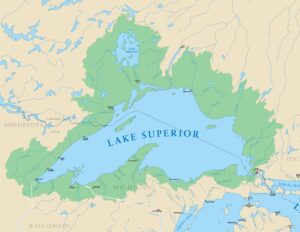
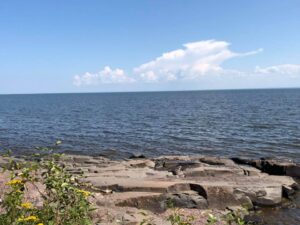 I was born on the tip of Lake Superior, in a little town called…you guessed it, Superior in Wisconsin. While my family moved to Casper, Wyoming when I was three years old, we have been back to Superior many times, and I still consider Superior, Wisconsin my hometown. It’s like the lake and that whole area is a part of my DNA. I love our visits back there, and so many of my cousins still live there, so there will always be ties to the area. I’ve read books about the many ships that have been victim to the storms and the rocky shores in some areas, and I love to look at pictures that some awesome people post on Facebook. I know about the name that was given by the Native Americans…Gitche Gumee, which means “Big Sea” or “Huge Water” just about always refers to Lake Superior. I know about the November Gales that hit Lake Superior every November, that can easily take down an unsuspecting ship that ventured out too late in the year.
I was born on the tip of Lake Superior, in a little town called…you guessed it, Superior in Wisconsin. While my family moved to Casper, Wyoming when I was three years old, we have been back to Superior many times, and I still consider Superior, Wisconsin my hometown. It’s like the lake and that whole area is a part of my DNA. I love our visits back there, and so many of my cousins still live there, so there will always be ties to the area. I’ve read books about the many ships that have been victim to the storms and the rocky shores in some areas, and I love to look at pictures that some awesome people post on Facebook. I know about the name that was given by the Native Americans…Gitche Gumee, which means “Big Sea” or “Huge Water” just about always refers to Lake Superior. I know about the November Gales that hit Lake Superior every November, that can easily take down an unsuspecting ship that ventured out too late in the year.
Some say Lake Superior is the largest of the Great Lakes. Some say it is actually an inland sea. It is the world’s largest freshwater lake. In fact, Lake Superior is in a class by itself…and that makes it a national treasure. Its character is very unique. It looks and feels like an ocean. If you have ever seen it, your first thought is that you can’t see to the other side…like an ocean. The Lake accommodates the big ships…big ore ships, big grain haulers, the really huge ships. When you watch them come into the port, you find yourself amazed that you could be standing there beside them. Their very entrance into the port is a daily tourist attraction…and the locals love it too. Some people say that “A day on Lake Superior leaves you exhilarated, connected, restored. The Lake’s energy courses through your bones right to your soul. What a gift.” Yes, Lake Superior is most definitely a gift to be sure.
Some scientists say that Lake Superior is truly an inland sea…even if it is fresh water and not salt water. The maritime agencies take weather, navigation and buoyage very seriously, and they monitor them carefully. People are not encouraged to venture out on Lake Superior until they have met the bottom-line amount of knowledge necessary to initiate a healthy relationship with the lake. That bottom-line amount of knowledge includes paying attention to equipment, your level of training, and definitely the surrounding environment. 
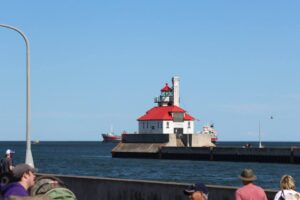 These are all important things that are recommended before a person ventures out onto any ocean or sea, which sort of classifies Lake Superior as an inland sea too. I suppose each person will have their own opinion on this, but since I have spent some time there, I tend to think that while it will always be Lake Superior to me, it will also be what I must agree, an inland sea.
These are all important things that are recommended before a person ventures out onto any ocean or sea, which sort of classifies Lake Superior as an inland sea too. I suppose each person will have their own opinion on this, but since I have spent some time there, I tend to think that while it will always be Lake Superior to me, it will also be what I must agree, an inland sea.


 My Aunt Doris Spencer is a wonderful woman who has always had a great sense of humor and a great imagination. When my mom, Collene Byer Spencer married my dad, Allen Spencer, they moved from Casper, Wyoming to Superior, Wisconsin. Dad’s family was from Superior, and most still lived there, so Dad was quite comfortable going home again. Mom was a young bride, who didn’t know anyone there, but found a new sister-in-law and best friend in Aunt Doris. They quickly became inseparable. They lived across the back yard from each other…there was no ally to separate the homes, but rather, just a fence and a gate. It was a great place to raise cousins, their children, together.
My Aunt Doris Spencer is a wonderful woman who has always had a great sense of humor and a great imagination. When my mom, Collene Byer Spencer married my dad, Allen Spencer, they moved from Casper, Wyoming to Superior, Wisconsin. Dad’s family was from Superior, and most still lived there, so Dad was quite comfortable going home again. Mom was a young bride, who didn’t know anyone there, but found a new sister-in-law and best friend in Aunt Doris. They quickly became inseparable. They lived across the back yard from each other…there was no ally to separate the homes, but rather, just a fence and a gate. It was a great place to raise cousins, their children, together.
I am reminded sometimes, of my aunt and uncle’s cabin at Lake Superior, and all the fun we had there over the years. Everything from time spent in the Lake, to the drive out too the lake. Wonderful memories all. My sister, Cheryl and I were talking about a particularly funny incident the other day. Our Uncle Bill was already at the cabin, and Aunt Doris and my cousin Pam, their daughter, were coming out later. As she drove, probably is a hurry for the weekend at the cabin to begin, she wasn’t really paying close attention to the speed of the car. Before she became aware that she was speeding, she heard sirens coming up behind her. Like most of us the feeling of immediate dread leapt up, but I don’t think Aunt Doris had ever received a ticket in her life. She was really very shook up about it. I’m not sure she even knew how shook up she was, but I’m sure that her daughter knew how shook up she was, because Aunt Doris mentioned later that Pam had said, “Are you afraid of that man, Mommy?”
The police officer, told her she had been speeding, and that he was going to have to give her a ticket. He went back to his car to write the ticket. For her part, Aunt Doris simply drove away. I can only imagine what went through the police officers mind. I’m sure he knew that Aunt Doris wasn’t any kind of a criminal. No one, whether they knew Aunt Doris or not, could possibly have though she could be a criminal. She simply wasn’t the type…couldn’t possibly be the type. So, he didn’t go after the woman who, being shook up, had driven away instead of waiting for her ticket.
Aunt Doris arrived at the cabin, and told Uncle Bill about the police officer and the speeding ticket. I’m sure that it was very clear to him that she was very shook up about the whole incident. After listening to her account of the traffic stop, Uncle Bill said, “Well ok. Let’s see the ticket.” Aunt Doris asked, a bit shocked, “What ticket?” Uncle Bill said, “The ticket he gave you!!” Then the realization came, probably to both of them, that there was no ticket, because she had simply driven away. Of course, my Uncle Bill, being quite mischievous, began to tell her that the police were going to be after her for leaving, and I can just picture my rather innocent aunt “freaking out” at the thought of the police showing up to “haul her off” in handcuffs. Of course, no such arrest ever took place, because the police officer, simply passed the event off as the actions of a woman who had never received a ticket before, and was terribly shook up about it. Besides, just imagine going back to the station and telling the guys that a woman drove away when he was trying to write her a ticket. Would he become the laughingstock, or maybe he did tell them, and they all laughed at the situation, and 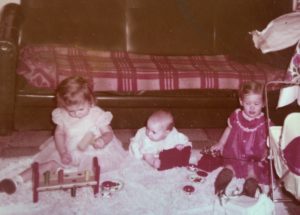
 agreed that he couldn’t give her a ticket now…he just couldn’t!!
agreed that he couldn’t give her a ticket now…he just couldn’t!!
Today is my Aunt Doris’ 96th birthday, and while she like most people in the United States is under lockdown, it isn’t because of any arrest, because that arrest never came. She is living quietly, still in Superior, Wisconsin, and doing very well indeed…clear in mind, and healthy in body, for which we are all thankful, Happy birthday Aunt Doris!! Have a great day!! We love you very much!!
 I was listening to a book recently about shipwrecks on the Great Lakes and a thought came to my mind that really made me quite sad…though definitely not as sad as when I consider the loss of life that took place in those many wrecks. My Uncle Bill Spencer told me years ago that the Great Lakes are littered with ships that were lost in some of the worst storms on the lakes. In fact, he told me that if you fly over Lake Superior, which is the lake near where he lived most of his life, you could actually see the ships on the bottom of the lake. That thought always made me want to charter a small plane and go see for myself.
I was listening to a book recently about shipwrecks on the Great Lakes and a thought came to my mind that really made me quite sad…though definitely not as sad as when I consider the loss of life that took place in those many wrecks. My Uncle Bill Spencer told me years ago that the Great Lakes are littered with ships that were lost in some of the worst storms on the lakes. In fact, he told me that if you fly over Lake Superior, which is the lake near where he lived most of his life, you could actually see the ships on the bottom of the lake. That thought always made me want to charter a small plane and go see for myself.
Shipwrecks aside, the book told of the different reasons that ships went down, and how the safety regulations were often extremely inadequate. From not enough lifeboats, to lifejackets that were stored to far from the posts to be reached, to companies who regularly pressured their 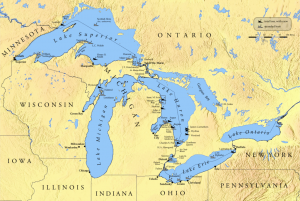 captains to take their ships out in terrible storms, the life of the sea was very dangerous. Of course, there are still shipwrecks today, although the last sinking on the Great Lakes was on November 10, 1975, when the SS Edmond Fitzgerald went down in a horrible November gale. With more recent safety regulations, the Great Lakes have been able to stave off shipwrecks in the last 45 years.
captains to take their ships out in terrible storms, the life of the sea was very dangerous. Of course, there are still shipwrecks today, although the last sinking on the Great Lakes was on November 10, 1975, when the SS Edmond Fitzgerald went down in a horrible November gale. With more recent safety regulations, the Great Lakes have been able to stave off shipwrecks in the last 45 years.
Still, it is not the number of wrecks, or even the lives lost, that has me considering a loss that is even greater…and least from the viewpoint of genealogy. As I was listening to the book, I heard that in several situations, they could not get an exact count of the lost, even if they technically knew how many were on board. The ships manifests had gone down with the ship. My mind raced. If there were people on those ships who had 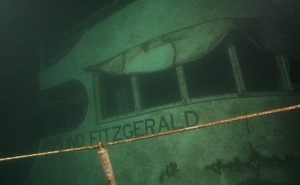 immigrated here, and their names were not recorded somewhere, they could virtually disappear and along with them, their line in the family tree they came from. I know that the many genealogy fanatics, like me, would just cringe at the thought of one of our ancestors simply vanishing. There are so many ways for a family line to get muddied. Name changes, marriages, undocumented deaths, as well as those who just left without telling anyone, are all among the lost ones, but I hadn’t considered those who meant to stay in touch, but who were never heard from, and their family back in Europe or wherever they came from, had no idea what happened. All they knew was that they were lost forever.
immigrated here, and their names were not recorded somewhere, they could virtually disappear and along with them, their line in the family tree they came from. I know that the many genealogy fanatics, like me, would just cringe at the thought of one of our ancestors simply vanishing. There are so many ways for a family line to get muddied. Name changes, marriages, undocumented deaths, as well as those who just left without telling anyone, are all among the lost ones, but I hadn’t considered those who meant to stay in touch, but who were never heard from, and their family back in Europe or wherever they came from, had no idea what happened. All they knew was that they were lost forever.

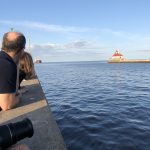 During our visit to Superior, Wisconsin, my sister, Cheryl Masterson; her daughter, Liz Masterson; and I were treated a couple of wonderful tours of the area. Our cousin, Pam Wendling and her husband Mike took us down to Canal Park, where we watched the Paul R Tragurtha coming into port to pick up a load of coal…that come to Duluth by train from none other than Gillette, Wyoming, by the way. The Paul R Tragurtha is known as the “Queen of the Lakes” and is the longest vessel on the Great Lakes at 1,013 feet 6 inches. Watching that great ship come into port is amazing. It was also great to have Pam and Mike there to give us the lake and ship history. Though we had been to Canal Park before, it just never gets old.
During our visit to Superior, Wisconsin, my sister, Cheryl Masterson; her daughter, Liz Masterson; and I were treated a couple of wonderful tours of the area. Our cousin, Pam Wendling and her husband Mike took us down to Canal Park, where we watched the Paul R Tragurtha coming into port to pick up a load of coal…that come to Duluth by train from none other than Gillette, Wyoming, by the way. The Paul R Tragurtha is known as the “Queen of the Lakes” and is the longest vessel on the Great Lakes at 1,013 feet 6 inches. Watching that great ship come into port is amazing. It was also great to have Pam and Mike there to give us the lake and ship history. Though we had been to Canal Park before, it just never gets old.
Pam and Mike also took us up the North Shore of Lake Superior to Two Harbors, Minnesota, and showed us all the 
 sights in that area. The lighthouse there is really pretty, and we were able to get lots of pictures. There was a ship in the harbor that was loading Taconite, which is a low-grade iron ore. For a long time, when the high-grade natural iron ore was plentiful, Taconite was considered a waste rock and not used. Then, as the supply of high-grade natural ore decreased, industry began to view Taconite as a resource. Had it not been for Mike’s knowledge of all these mining, railroad, and shipping industries in the area, and in the United States, we would have seen these things, but really wouldn’t have know anything about the rich history that went along with it. It takes someone, like Mike, with a love of history to give us that.
sights in that area. The lighthouse there is really pretty, and we were able to get lots of pictures. There was a ship in the harbor that was loading Taconite, which is a low-grade iron ore. For a long time, when the high-grade natural iron ore was plentiful, Taconite was considered a waste rock and not used. Then, as the supply of high-grade natural ore decreased, industry began to view Taconite as a resource. Had it not been for Mike’s knowledge of all these mining, railroad, and shipping industries in the area, and in the United States, we would have seen these things, but really wouldn’t have know anything about the rich history that went along with it. It takes someone, like Mike, with a love of history to give us that.
Pam and Mike also do some hiking in the area, and we were shown some of the beautiful hiking trails, and the 
 beautiful wooded areas around the lake. The streams and waterfalls especially appealed to us. That area has so many more trees that we have in Wyoming, and all that greenery made me long to get out and wander down the trail, but we just didn’t have the time, unfortunately. Pam suggested that Bob and I consider a hiking trip to the area, we may have to try to do that. The tours were beautiful, and the time we spent with them was very special to us. I am so glad that we have reconnected with all of our cousins in the Superior/Duluth area, and all over the nation. Amazing family connections.
beautiful wooded areas around the lake. The streams and waterfalls especially appealed to us. That area has so many more trees that we have in Wyoming, and all that greenery made me long to get out and wander down the trail, but we just didn’t have the time, unfortunately. Pam suggested that Bob and I consider a hiking trip to the area, we may have to try to do that. The tours were beautiful, and the time we spent with them was very special to us. I am so glad that we have reconnected with all of our cousins in the Superior/Duluth area, and all over the nation. Amazing family connections.
 Many people think of the Indians as, well…simply the Indians, whether we intend to or not. I suppose that if we studied the different tribes, their noticeable differences would become very apparent, but if we don’t it’s not so easy to tell them apart. One of the lesser known tribes, at least early on in American history, was the Chippewa tribe. Speculation is that they were already settled in a large village at La Pointe, Wisconsin at about the time that America was discovered. Then, in the early 17th century, they abandoned this area. Many of them returning to their homeland in Sault Sainte Marie, Michigan, while others settled at the west end of Lake Superior, where they were found by Father Claude Jean Allouez, a Jesuit missionary and French explorer, in 1865.
Many people think of the Indians as, well…simply the Indians, whether we intend to or not. I suppose that if we studied the different tribes, their noticeable differences would become very apparent, but if we don’t it’s not so easy to tell them apart. One of the lesser known tribes, at least early on in American history, was the Chippewa tribe. Speculation is that they were already settled in a large village at La Pointe, Wisconsin at about the time that America was discovered. Then, in the early 17th century, they abandoned this area. Many of them returning to their homeland in Sault Sainte Marie, Michigan, while others settled at the west end of Lake Superior, where they were found by Father Claude Jean Allouez, a Jesuit missionary and French explorer, in 1865.
The Chippewa, also known as the Ojibway, Ojibwe, and Anishinaabe, are one of the largest and most powerful nations, having nearly 150 different bands located primarily in Minnesota, Wisconsin, Michigan, and southern Canada…especially Ontario, Manitoba and Saskatchewan. Ojibway means “to roast till puckered up.” It’s an odd name that referred to the puckered seam on their moccasins. Formerly, the tribe lived along both shores of Lakes Huron and Superior, extending across the Minnesota Turtle Mountains and North Dakota. They were strong in numbers and occupied an large territory, but the Chippewa were never prominent in history, mainly because of their remoteness from the frontier during the period of the colonial wars. They were part of an Algonquian group, including the Ottawa and Potawatomi, which divided when it reached Mackinaw in its westward movement.
Sault Saint Marie was their main headquarters about 1640, as mentioned by Jean Nicolet de Belleborne, a French-Canadian woodsman, who called them Baouichtigouin, meaning “people of the Sault”. In 1642, they 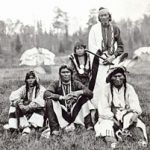 were visited by missionaries Charles Raymbaut and Isaac Jogues, who found them at the Sault and at war with a people to the west, who were probably the Sioux. Because they kept to themselves, away from the frontier, the Chippewa took a very small part in the early colonial wars, but the southern division of the tribe was known to be of warlike disposition. Those to the north of Lake Superior were considered to be peaceful. They were termed by their southern brothers as “the rabbits.” In the north, the members of the tribe were described as the “men of the thick woods” and the “swamp people,” terms used to designate the nature of the country they lived in.
were visited by missionaries Charles Raymbaut and Isaac Jogues, who found them at the Sault and at war with a people to the west, who were probably the Sioux. Because they kept to themselves, away from the frontier, the Chippewa took a very small part in the early colonial wars, but the southern division of the tribe was known to be of warlike disposition. Those to the north of Lake Superior were considered to be peaceful. They were termed by their southern brothers as “the rabbits.” In the north, the members of the tribe were described as the “men of the thick woods” and the “swamp people,” terms used to designate the nature of the country they lived in.
The Chippewa people living south of Lake Superior in the late 1600s were fishermen and hunters. They also grew corn and wild rice. Their possession of wild-rice fields was one of the chief causes of their wars with the Dakota, Fox, and other nations. At about this time, they came into possession of firearms, and began pushing their way westward, in a mixture at peace and war with the Sioux but in almost constant conflict with the Fox tribe. The French, in 1692, reestablished a trading post at Shaugawaumikong, now La Pointe Island, Wisconsin, which became an important Chippewa settlement. In the beginning of the 18th century the Chippewa succeeded in driving the Fox, already reduced by war with the French, from north Wisconsin, compelling them to take refuge with the Sac.
The Chippewa took part with the other tribes of the northwest in all the wars against the frontier settlements to  the close of the war of 1812. Those living within the United States made a treaty with the Government in 1815, and afterwards remained peaceful, residing on reservations or allotted lands within their original territory in Michigan, Wisconsin, Minnesota, and North Dakota. By 1900, the Chippewa were estimated to number about 30,000. Today, the collective bands of Chippewa or Ojibwe, are one of the largest groups of Native American People on the North American continent. There are communities in both Canada and the United States. In Canada, they are the second largest population among First Nations, surpassed only by the Cree. In the United States, they have the fourth largest population among Native American tribes, surpassed only by the Navajo, Cherokee and Lakota Sioux.
the close of the war of 1812. Those living within the United States made a treaty with the Government in 1815, and afterwards remained peaceful, residing on reservations or allotted lands within their original territory in Michigan, Wisconsin, Minnesota, and North Dakota. By 1900, the Chippewa were estimated to number about 30,000. Today, the collective bands of Chippewa or Ojibwe, are one of the largest groups of Native American People on the North American continent. There are communities in both Canada and the United States. In Canada, they are the second largest population among First Nations, surpassed only by the Cree. In the United States, they have the fourth largest population among Native American tribes, surpassed only by the Navajo, Cherokee and Lakota Sioux.
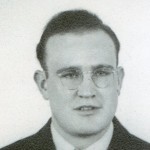
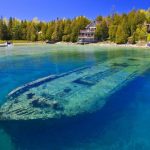 In September of 1975, my husband, Bob Schulenberg and I made a trip to Superior, Wisconsin to visit my Uncle Bill Spencer and his family. Uncle Bill and I had always been close, and it was a trip I thoroughly enjoyed. Part of the trip included driving around the shores of Lake Superior, while Uncle Bill gave us some history of the area, including the many shipwrecks that had occurred in the lake. Lake Superior is the largest fresh water lake in the world, and in reality it is more a sea than a lake. The lake experiences treacherous storms, especially in November when the Winter gales sweep over the it. With a huge shipping industry operating on the lake every year, accidents are bound to happen periodically, especially if a ship is caught out on the lake too late in the season. Listening to Uncle Bill tell us about the ghosts of Lake Superior, as the wrecks were called, and how you could see them beneath the water if you flew over the lake, peeked my curiosity about when and where the ships had lost their battles with the lake.
In September of 1975, my husband, Bob Schulenberg and I made a trip to Superior, Wisconsin to visit my Uncle Bill Spencer and his family. Uncle Bill and I had always been close, and it was a trip I thoroughly enjoyed. Part of the trip included driving around the shores of Lake Superior, while Uncle Bill gave us some history of the area, including the many shipwrecks that had occurred in the lake. Lake Superior is the largest fresh water lake in the world, and in reality it is more a sea than a lake. The lake experiences treacherous storms, especially in November when the Winter gales sweep over the it. With a huge shipping industry operating on the lake every year, accidents are bound to happen periodically, especially if a ship is caught out on the lake too late in the season. Listening to Uncle Bill tell us about the ghosts of Lake Superior, as the wrecks were called, and how you could see them beneath the water if you flew over the lake, peeked my curiosity about when and where the ships had lost their battles with the lake.
Just a month later, on November 10, 1975, while driving around the lake on his way back from a gun show, Uncle Bill experienced the gales of November from the lake shore, not knowing at the time that the SS Edmond Fitzgerald was fighting for its life, in a losing battle on the lake. The ship had made a run for it from Superior, Wisconsin, but found itself in serious trouble the next day. This was not going to be a battle the ship or her  crew would survive. The SS Edmund Fitzgerald had once been the largest and fastest ship on the Great Lakes, at 729 feet in length. First launched in 1958, its service would be cut short that fateful day in 1975.
crew would survive. The SS Edmund Fitzgerald had once been the largest and fastest ship on the Great Lakes, at 729 feet in length. First launched in 1958, its service would be cut short that fateful day in 1975.
The ship left Burlington Northern Railroad Dock, Number 1 at Superior, Wisconsin on November 9th, carrying 26,116 tons of iron ore pellets. The next day it was hit with a storm packing 60 mile per hour winds and waves in excess of 15 feet. Captain Ernest McSorley steered north, trying to make it to safety in Whitefish Bay, but then the radar failed and the storm took out the power at Whitefish Bay taking with it Whitefish Point’s radio beacon. McSorley was traveling blind. The huge wave swept over the ship, and it began taking on water. A ship taking on water is never a good thing, but when you add to that 26,116 tons of iron ore pellets, that ship is in trouble. Another ship, the Anderson stayed in radio contact with the Fitzgerald, trying to help it reach the bay, but to no avail. Just after 7pm on November 10th, 17 miles from Whitefish Bay, the Fitzgerald made its last radio transmission. The ship, sunk lower and lower from the added weight of the water until its bow pitched down into the lake and the vessel was unable to recover. The ship broke in two, either from waves and water or on its way to the bottom, taking with it cargo and crew. None of the 29 men aboard survived.
It’s not hard to imagine why the shipwrecks are called the Ghosts of Lake Superior, because many, if not all of 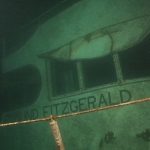
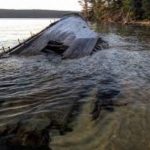 them took with them the men and women who had been their crew. Most of those lost souls are still there in a watery grave, because it is too difficult to recover the bodies. The Edmund Fitzgerald now lies under 530 feet of water, broken in two sections. It is just one of at least 52 ships that litter the bottom of the lake. On July 4, 1995, the ship’s bell was recovered from the wreck, and a replica, engraved with the names of the crew members who perished in this tragedy, was left in its place. The original bell is on display at the Great Lakes Shipwreck Museum at Whitefish Point in Michigan.
them took with them the men and women who had been their crew. Most of those lost souls are still there in a watery grave, because it is too difficult to recover the bodies. The Edmund Fitzgerald now lies under 530 feet of water, broken in two sections. It is just one of at least 52 ships that litter the bottom of the lake. On July 4, 1995, the ship’s bell was recovered from the wreck, and a replica, engraved with the names of the crew members who perished in this tragedy, was left in its place. The original bell is on display at the Great Lakes Shipwreck Museum at Whitefish Point in Michigan.
 Over the centuries, metals or the discovery of metals have been something that has created everything from excitement to violence. Probably the best known discovery was that of gold, and while it is very valuable, there are many other very important metals, like iron, for instance. Very seldom do we think about all the things that are made with iron, and what an inexpensive, yet versatile metal it is. Iron is one of the most abundant metals found on earth, making up close to five percent of its crust. These iron minerals are typically mixed with clay, sand, rock or gravel. Iron is so common that it may be found in your backyard. Nevertheless, it is only mined commercially when the concentration is large enough to make it worth going after. Iron is used in cookware, fencing, vehicles, motors, buildings, and steel, just to name a few. And, every American born will need 27,416 pounds of iron in their lifetime.
Over the centuries, metals or the discovery of metals have been something that has created everything from excitement to violence. Probably the best known discovery was that of gold, and while it is very valuable, there are many other very important metals, like iron, for instance. Very seldom do we think about all the things that are made with iron, and what an inexpensive, yet versatile metal it is. Iron is one of the most abundant metals found on earth, making up close to five percent of its crust. These iron minerals are typically mixed with clay, sand, rock or gravel. Iron is so common that it may be found in your backyard. Nevertheless, it is only mined commercially when the concentration is large enough to make it worth going after. Iron is used in cookware, fencing, vehicles, motors, buildings, and steel, just to name a few. And, every American born will need 27,416 pounds of iron in their lifetime.
On this day September 5, 1844, iron ore was discovered in Minnesota’s Mesabi Range. The discovery was made  while the miners were on their way to prospect for gold. Because gold was the metal everyone was excited about, the iron ore was virtually ignored. As metals go, the iron would become far more valuable in northern Minnesota than gold. In fact, for the past 50 years, Lake Superior iron ore accounts for 90% of United States iron ore production, with much of that ore coming from the Mesabi Range, where that first discovery occurred back in 1844. Iron ore makes up the majority of Lake Superior shipping, and would soon become the most lucrative occupation in the Lake Superior shipping industry. Just imagine if you were one of those men who walked away from the iron ore discovery, in search of gold, which most never found. Wouldn’t you be kicking yourself now? There were millions to be made in the iron industry.
while the miners were on their way to prospect for gold. Because gold was the metal everyone was excited about, the iron ore was virtually ignored. As metals go, the iron would become far more valuable in northern Minnesota than gold. In fact, for the past 50 years, Lake Superior iron ore accounts for 90% of United States iron ore production, with much of that ore coming from the Mesabi Range, where that first discovery occurred back in 1844. Iron ore makes up the majority of Lake Superior shipping, and would soon become the most lucrative occupation in the Lake Superior shipping industry. Just imagine if you were one of those men who walked away from the iron ore discovery, in search of gold, which most never found. Wouldn’t you be kicking yourself now? There were millions to be made in the iron industry.
Shipping on Lake Superior is dominated by iron ore cargo. Of course, that is not the only thing shipped, but the 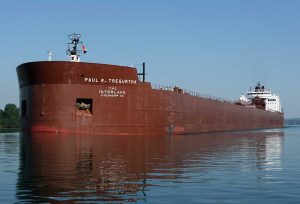 iron ore ships, which are always called ore boats, are among the most amazing in my book. The largest ore boat, the Paul R. Tregurtha is the reigning “Queen of the Lakes” title holder as the longest vessel on the Great Lakes at 1,013 feet 6 inches was constructed in two sections. When my mom, Collene Spencer, my sister, Cheryl Masterson, and I were in Superior three years ago, we got to see this amazing vessel as it left port. Of all the ships on Lake Superior, the ore boats are the ones most people think of when they think of ships on the lake. For people who make their living on the lake, the ore boats are their bread and butter. And to think it all started with a discovery that no one seemed to care about. In the end, it was an unexpected gold mine.
iron ore ships, which are always called ore boats, are among the most amazing in my book. The largest ore boat, the Paul R. Tregurtha is the reigning “Queen of the Lakes” title holder as the longest vessel on the Great Lakes at 1,013 feet 6 inches was constructed in two sections. When my mom, Collene Spencer, my sister, Cheryl Masterson, and I were in Superior three years ago, we got to see this amazing vessel as it left port. Of all the ships on Lake Superior, the ore boats are the ones most people think of when they think of ships on the lake. For people who make their living on the lake, the ore boats are their bread and butter. And to think it all started with a discovery that no one seemed to care about. In the end, it was an unexpected gold mine.
 It happens every year, although maybe not to this degree, but when it has been a long cold winter, the ice can get really thick on Lake Superior, and when it begins to thaw, ice can make its way onto the shoreline because of the movement of the deep water. I saw a video a few days ago that showed Lake Superior thawing and the ice shards coming ashore. They weren’t thick, because this Winter, while bad enough back there, was not as bad as the one we had in 1958, when I was almost two years old. That year, the ice was so thick, that it came ashore as very large ice slabs. When the ice comes into the shore on Lake Superior, it can overflow onto streets and yards near the shore.
It happens every year, although maybe not to this degree, but when it has been a long cold winter, the ice can get really thick on Lake Superior, and when it begins to thaw, ice can make its way onto the shoreline because of the movement of the deep water. I saw a video a few days ago that showed Lake Superior thawing and the ice shards coming ashore. They weren’t thick, because this Winter, while bad enough back there, was not as bad as the one we had in 1958, when I was almost two years old. That year, the ice was so thick, that it came ashore as very large ice slabs. When the ice comes into the shore on Lake Superior, it can overflow onto streets and yards near the shore.
I can’t say that I recall the time we spent on the ice slabs that year, but apparently the 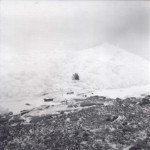 ice slabs, shards, or just ice in general are things that the people along Lake Superior celebrate. I suppose when Winter is a longer lasting season, finding a way to have fun in it is essential. Enter the Ice Festival. From what I can see, and I hope some of my Duluth/Superior family members will fill me in, there are a number of events. On the website, I saw ice sculptures, ice princesses, bon fires and s’mores, warming houses with hot drinks to warm up with, food, fireworks, children’s story time, and crafts, so there is truly something for everyone, and it’s all about having fun.
ice slabs, shards, or just ice in general are things that the people along Lake Superior celebrate. I suppose when Winter is a longer lasting season, finding a way to have fun in it is essential. Enter the Ice Festival. From what I can see, and I hope some of my Duluth/Superior family members will fill me in, there are a number of events. On the website, I saw ice sculptures, ice princesses, bon fires and s’mores, warming houses with hot drinks to warm up with, food, fireworks, children’s story time, and crafts, so there is truly something for everyone, and it’s all about having fun.
I don’t know if we were at an Ice Festival when my parents took us out to see the ice slabs on Lake Superior’s shores, but in looking at the pictures, I must say that they were definitely impressive. I know that the ice festival is not as much about the ice  slabs around the lake, but rather about the fact that, at this point, most people are really over Winter by now. Finding fun things to do that are associated with ice, as well as the coming Spring, is a way to lift everyone’s spirits. I can tell from the pictures my parents took at the time, that they and we were impressed with ice slabs that had come on shore that year. I think anyone would have been impressed, because they were huge that year. Some of them were half my height, not that I was tall, but that really is pretty thick. I’m sure it was somewhat cold out there, and back then, little girls wore dresses a lot of the time, but my sister, Cheryl Masterson, and I did not seem to mind the cold. I guess it was the wonder of it all. Maybe that is why they have an Ice Festival..so people can embrace the ice…so to speak.
slabs around the lake, but rather about the fact that, at this point, most people are really over Winter by now. Finding fun things to do that are associated with ice, as well as the coming Spring, is a way to lift everyone’s spirits. I can tell from the pictures my parents took at the time, that they and we were impressed with ice slabs that had come on shore that year. I think anyone would have been impressed, because they were huge that year. Some of them were half my height, not that I was tall, but that really is pretty thick. I’m sure it was somewhat cold out there, and back then, little girls wore dresses a lot of the time, but my sister, Cheryl Masterson, and I did not seem to mind the cold. I guess it was the wonder of it all. Maybe that is why they have an Ice Festival..so people can embrace the ice…so to speak.
 For the first three years of my life, I was my parents’ youngest child, and my sister, Cheryl Spencer Masterson, their oldest, of course. That meant that while our dad, Allen Spencer worked, Cheryl and I got to hang out with Mom. And since we lived just across the yard from my Uncle Bill Spencer and Aunt Doris Spencer, we got to hang out with Aunt Doris and our cousin Pam Spencer Wendling as well. Oh, the times we had!! Of course, our dads were there too, and then we got to go other places and do things that the moms wouldn’t take us to do alone. Those were either too far or too crowded. I think for my dad, taking us out to Lake Superior was the most special thing to do. He loved taking pictures of his girls enjoying the sunshine, the outdoors, and the time spent with mom and dad…even though it looks like it was just the girls hanging out with Mom. In reality, the time girls spend with their moms show them what women should be like…a very good reason for moms to be careful about the way they come across to their girls. Little girls watch their mom clean and cook. They watch the way they dress, and how they act, and how they treat their husband. Boys do the same thing with their dads, but today is about hanging out with my mom.
For the first three years of my life, I was my parents’ youngest child, and my sister, Cheryl Spencer Masterson, their oldest, of course. That meant that while our dad, Allen Spencer worked, Cheryl and I got to hang out with Mom. And since we lived just across the yard from my Uncle Bill Spencer and Aunt Doris Spencer, we got to hang out with Aunt Doris and our cousin Pam Spencer Wendling as well. Oh, the times we had!! Of course, our dads were there too, and then we got to go other places and do things that the moms wouldn’t take us to do alone. Those were either too far or too crowded. I think for my dad, taking us out to Lake Superior was the most special thing to do. He loved taking pictures of his girls enjoying the sunshine, the outdoors, and the time spent with mom and dad…even though it looks like it was just the girls hanging out with Mom. In reality, the time girls spend with their moms show them what women should be like…a very good reason for moms to be careful about the way they come across to their girls. Little girls watch their mom clean and cook. They watch the way they dress, and how they act, and how they treat their husband. Boys do the same thing with their dads, but today is about hanging out with my mom.
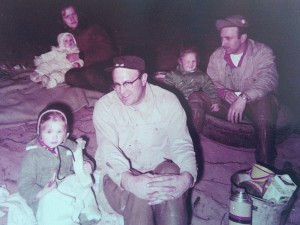
I can’t say that I always followed Mom’s examples on things, we were two different people, after all, and we led different lives as adult women. Still, my mom’s values, or her teaching thereof, took root, and are still with me to this day. While I didn’t always understand why she liked things the way she did sometimes, I do understand why now. I was a different person then, younger and less aware of how I would feel about things in the future. And now that my mom is in Heaven, I can’t tell you just how often I would love to call her up to get her advise on things. I think that it is so unfortunate that kids don’t realize just how important their parents are to them, until its too late. Of course, I knew that my parents were very important to me, but even though I can say that honestly, I can also honestly say that I still didn’t know just how important they were until that were gone, because once your parents are gone, the missing them is endless. You look back on the times you had with them, now with the full awareness that you can’t have those times again on this Earth, and you find out just how precious those times were. Your mind starts thinking just how much you wish you could go back, while carrying the knowledge you now have, and spend those precious moments focused on your parents more, and 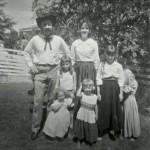 not just acknowledging that they are your parents, while thinking that they will always be there. Truly, if we could do that, more of us would probably hang out with them a little more often, and not squander that precious time.
not just acknowledging that they are your parents, while thinking that they will always be there. Truly, if we could do that, more of us would probably hang out with them a little more often, and not squander that precious time.
Today, marks 11 months since my mom went to Heaven. I miss her every day, and never a day goes by that I don’t think of her and Dad, now happily together again forever. I know they know how much we all love them, but they are so happy in Heaven, that I truly cannot wish them back to a world filled with the ugliness of today. Nevertheless, I look forward to the day when we will all be together again, so we can hang out for eternity. We love and miss you Mom and Dad. We will see you soon.
 When we think of hurricanes, we think of the ocean, but on November 7, 1913, there was a storm over the Great Lakes that would go down in United States history as the largest inland maritime disaster, in terms of number of ships lost. The storm was nicknamed the White Hurricane. The storm system brought blizzard conditions to areas all around the Great Lakes, with hurricane force winds. The nature of the storm was unique and powerful, and caught even the most seasoned captain by surprise. Two low pressure centers merged and rapidly intensified over the Lake Huron, with periods of storm-force winds occurring over a four day period. Surrounding ports signaled it was a level-four storm, but for some vessels, it was already too late. Major ship wrecks took place on all the Great Lakes except for Lake Ontario. Vessels at that time could withstand 90 mile per hour winds and 35 foot waves, but it was the whiteout conditions and accumulation of ice on the ships that turned an already dangerous situation into a deadly one. Ship captains were unable to maintain navigation, resulting in 12 shipwrecks, 19 ships stranded, and an estimated 250 lives lost. On land, 24 inches of snow shut down traffic and communication, causing millions of dollars in damage.
When we think of hurricanes, we think of the ocean, but on November 7, 1913, there was a storm over the Great Lakes that would go down in United States history as the largest inland maritime disaster, in terms of number of ships lost. The storm was nicknamed the White Hurricane. The storm system brought blizzard conditions to areas all around the Great Lakes, with hurricane force winds. The nature of the storm was unique and powerful, and caught even the most seasoned captain by surprise. Two low pressure centers merged and rapidly intensified over the Lake Huron, with periods of storm-force winds occurring over a four day period. Surrounding ports signaled it was a level-four storm, but for some vessels, it was already too late. Major ship wrecks took place on all the Great Lakes except for Lake Ontario. Vessels at that time could withstand 90 mile per hour winds and 35 foot waves, but it was the whiteout conditions and accumulation of ice on the ships that turned an already dangerous situation into a deadly one. Ship captains were unable to maintain navigation, resulting in 12 shipwrecks, 19 ships stranded, and an estimated 250 lives lost. On land, 24 inches of snow shut down traffic and communication, causing millions of dollars in damage.
The storm took place before the time when weather forecasters had the luxury of computer models, the detailed surface and upper air observations, weather satellites, or radar needed to make the most accurate predictions. Had weather forecasters then been able to access modern forecasting equipment, they may have been able to determine the likely development of this type of storm system in advance, as they did with Superstorm Sandy in 2012. As part of the forecast for Sandy forecasters were able to predict storm force winds over the lower Great Lakes five days in advance. The technology and forecast models available to forecasters today led to a more accurate forecast which saved mariners, recreational boaters, and businesses millions, as they were able to make preparations in advance of Sandy’s storm force winds and near 20 foot waves.
One hundred years later, the National Oceanic and Atmospheric Administration, in the Great Lakes is commemorating the Storm of 1913, not only for the pivotal role it played in the history of the Great Lakes, but also for its enduring influence. Modern systems of shipping communication, weather prediction, and storm preparedness have all been fundamentally shaped by the events of November 1913. It’s strange to think that one storm could make such a lasting impact on so many systems, but then it is the need for something better that spurs great inventive minds to invent a solution to a serious problem.
The National Oceanic and Atmospheric Administration plays a major role in protecting maritime relics of the past. Included are many of the ships lost in 1913. They have remained preserved deep below the surface of the Great Lakes. The National Oceanic and Atmospheric Administration’s Thunder Bay National Marine Sanctuary is a 48-square-mile area of protected territory with one of America’s best preserved and nationally significant collections of shipwrecks. Located in northwestern Lake Huron, Thunder Bay is adjacent to one of the most treacherous stretches of water within the Great Lakes system. Unpredictable weather, murky fog banks, sudden gales, and rocky shoals earned the area the name “Shipwreck Alley.” To date, more than 50 shipwrecks have been discovered within the sanctuary including the Isaac M. Scott, a 504 foot steel freighter lost in the storm of 1913.
This storm holds an interest for me, because at that time in history, my grandparents, Allen and Anna Spencer were living in the Great Lakes area. My grandfather was not part of the crew of any ship, and so any effect to them would have come in the form of very deep snow. My Aunt Laura would have been just 16 months old at 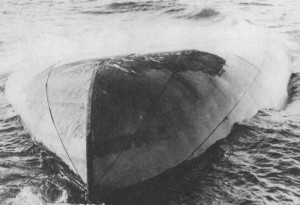 the time. I’m sure that the thought of being stranded in her home, was not a pleasant one for my grandmother, considering Aunt Laura’s very young age, but they survived the White Hurricane, as did most other people, at least those on land anyway. It still seems incredible to me that a storm of that magnitude could have brewed in an inland setting, but then anyone who knows the Great Lakes will tell you that they are so big that they might just as well be considered a sea. The November Gales have long been known as killers, especially over Lake Superior, the largest of the Great Lakes. I’m glad that modern weather forecasting equipment had at least lessened the possibility of ships and lives being lost in the Great Lakes, as well as the oceans.
the time. I’m sure that the thought of being stranded in her home, was not a pleasant one for my grandmother, considering Aunt Laura’s very young age, but they survived the White Hurricane, as did most other people, at least those on land anyway. It still seems incredible to me that a storm of that magnitude could have brewed in an inland setting, but then anyone who knows the Great Lakes will tell you that they are so big that they might just as well be considered a sea. The November Gales have long been known as killers, especially over Lake Superior, the largest of the Great Lakes. I’m glad that modern weather forecasting equipment had at least lessened the possibility of ships and lives being lost in the Great Lakes, as well as the oceans.

